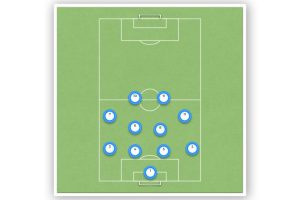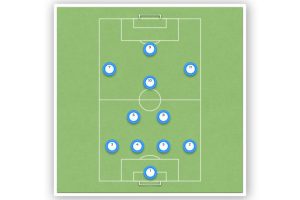The Origin of the 4-4-2 Formation in Soccer: A Historical Perspective
The 4-4-2 formation is one of the most popular and widely used formations in soccer. It is a classic formation that has been around since the early 20th century, and it has seen slight modifications over time due to changes in tactics within the game itself. The formation is made up of 4 defenders, 4 midfielders, and 2 strikers. It is a balanced formation that provides both defensive and attacking options for the team.
The origin of the 4-4-2 formation can be traced back to the 1880s when soccer was still in its infancy. At that time, the game was played with a 2-3-5 formation, which consisted of two defenders, three midfielders, and five forwards. This formation was highly attacking, and teams would often score many goals, but they would also concede a lot of goals. As the game evolved, teams started to adopt more defensive formations, and the 4-4-2 formation emerged as one of the most popular formations.
The Evolution of Soccer Formations
Soccer formations have evolved over the years, with different coaches and teams experimenting with new systems. The earliest formations were simple and focused on defense, with teams lining up in a straight line across the field. As the game evolved, formations became more complex, with teams adopting different shapes and structures to suit their playing style and personnel.
One of the most popular formations in soccer history is the 4-4-2, which was first used in the 1930s. The 4-4-2 formation is a balanced system that features four defenders, four midfielders, and two forwards. It is a versatile formation that can be used to defend deep or attack with pace and width.
The 4-4-2 formation was initially developed as a response to the WM formation, which was popular in the 1920s. The WM formation featured three defenders, two midfielders, and five forwards, and was designed to overwhelm opposing defenses with attacking numbers. The 4-4-2 formation, with its four defenders and four midfielders, provided a more balanced approach that could counter the WM formation’s attacking threat while still offering a potent attacking threat of its own.
Over time, the 4-4-2 formation has been adapted and modified to suit different playing styles and tactical approaches. Some teams have used a diamond midfield to provide more attacking support, while others have used a flat midfield to focus on defensive solidity. The 4-4-2 formation has also been used as a foundation for other systems, such as the 4-2-3-1 and the 4-3-3.
| Formation | Defenders | Midfielders | Forwards |
|---|---|---|---|
| 4-4-2 | 4 | 4 | 2 |
| 4-2-3-1 | 4 | 2 | 3 |
| 4-3-3 | 4 | 3 | 3 |
Despite the emergence of new formations in modern soccer, the 4-4-2 remains a popular and effective system that is used by many top teams around the world. Its simplicity and versatility make it a great choice for coaches who are looking for a balanced approach that can adapt to different situations.
The Birth of the 4-4-2 Formation
The 4-4-2 formation has been a staple of modern soccer for decades. It is a formation that has been used by some of the world’s top professional teams and has been the foundation of many successful campaigns throughout the history of the sport. The 4-4-2 formation is a balanced formation that provides stability in the midfield and defensive areas while allowing for a strong attacking presence.
The origins of the 4-4-2 formation can be traced back to the early 1960s when a Hungarian coach named Márton Bukovi introduced the formation to the world. Bukovi was the coach of the Hungarian team Újpest FC and he used the 4-4-2 formation to great effect during his tenure. The formation was later popularized by the English coach Alf Ramsey who used it to lead England to victory in the 1966 World Cup.
The 4-4-2 formation is a classic formation that is easy to understand and execute. It consists of four defenders, four midfielders, and two forwards. The defenders are split into two center-backs and two full-backs. The midfielders are split into two central midfielders and two wide midfielders. The forwards are split into a target man and a second striker. This formation provides a balance between defense and attack and allows for quick transitions from defense to attack.
| Advantages | Disadvantages |
|---|---|
| Easy to understand and execute | Can be predictable |
| Provides balance between defense and attack | Can be vulnerable to counter-attacks |
| Allows for quick transitions from defense to attack | Requires a strong target man |
The 4-4-2 formation has evolved over time and has been adapted to suit different playing styles and team compositions. It has been used by some of the greatest teams in the world and has been the foundation of many successful campaigns throughout the history of the sport. The 4-4-2 formation is a classic formation that will continue to be used for many years to come.
The Tactical Advantages of the 4-4-2 Formation
The 4-4-2 formation is one of the most popular formations in soccer. This formation has been used by many successful teams throughout history. The 4-4-2 formation offers a number of tactical advantages that make it an attractive option for coaches and players alike.
Solid Defensive Structure
The 4-4-2 formation provides a solid defensive structure that can be difficult for opposing teams to break down. With four defenders at the back, the defense is well-organized and can cover a large area of the field. The two central defenders can focus on marking the opposing team’s strikers, while the full-backs can provide support on the flanks. This structure can help prevent the opposition from scoring goals and can provide a solid foundation for the team to build from.
Effective Midfield Presence
The 4-4-2 formation provides an effective midfield presence that can control the game and dictate the pace of play. With four midfielders, the team can dominate the central areas of the pitch and prevent the opposition from gaining a foothold. The central midfielders can provide a link between defense and attack, while the wide midfielders can provide width and support on the flanks. This structure can help the team to control possession and create scoring opportunities.
Versatile Attacking Options
The 4-4-2 formation provides versatile attacking options that can create problems for opposing defenses. With two forwards, the team can play with a target man and a supporting striker, or with two strikers who can combine and interchange positions. This can create confusion for the opposition and make it difficult for them to mark the attacking players effectively. The wide midfielders can also provide support and create scoring opportunities with crosses and through balls.
| Advantages | Disadvantages |
|---|---|
| Provides a solid defensive structure | Can be vulnerable to counter-attacks |
| Effective midfield presence | Can be outnumbered in midfield |
| Versatile attacking options | Can be predictable if not used creatively |
The Influence of the 4-4-2 Formation in Modern Soccer
The 4-4-2 formation has had a significant impact on modern soccer. It has been used by some of the most successful teams in history and has inspired other formations that are still in use today.
Variations of the 4-4-2 Formation
One of the reasons for the popularity of the 4-4-2 formation is its versatility. Teams can adapt the formation to suit their style of play and the strengths of their players.
One variation of the 4-4-2 formation is the diamond formation. This formation adds a defensive midfielder to the midfield, creating a diamond shape. This allows for greater control of the central midfield areas and better possession of the ball. However, it sacrifices the natural width that the traditional 4-4-2 offers.
Another variation is the flat four across the midfield. This variation is more defensive, with two central midfielders and two wide midfielders who are expected to track back and help defend. This formation is useful when a team needs to protect a lead or defend against a strong attacking team.
Other Formations Inspired by the 4-4-2
The 4-4-2 formation has also inspired other formations that are still in use today. One example is the 4-2-3-1 formation, which adds an attacking midfielder behind the striker. This allows for greater creativity in attack and more options for scoring goals.
Another example is the 3-5-2 formation, which uses three central defenders, two wing-backs, and three central midfielders. This formation is useful when a team wants to dominate possession and control the midfield.
| Formation | Description | Pros | Cons |
|---|---|---|---|
| 4-4-2 | Four defenders, four midfielders, two strikers | Versatile, balanced, good for counter-attacking | Lacks creativity, vulnerable on the wings |
| 4-2-3-1 | Four defenders, two defensive midfielders, three attacking midfielders, one striker | More attacking options, allows for greater creativity | Weaker defensively, vulnerable on the wings |
| 3-5-2 | Three central defenders, two wing-backs, three central midfielders, two strikers | Good for possession, strong in midfield | Vulnerable in defense, lacks width |
Overall, the 4-4-2 formation has had a significant impact on modern soccer. Its versatility and efficiency have inspired other formations and tactics that are still in use today. While it may not be the most creative or attacking formation, it remains a popular choice for teams at all levels of the game.





